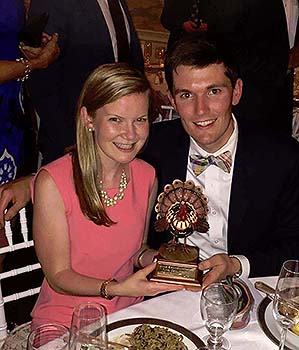


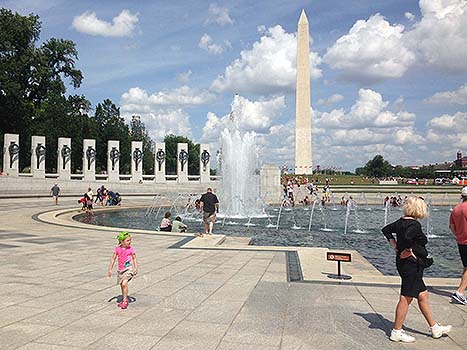


This trip was organized around two weddings to which we were invited, both involving the daughters of some old friends. (Well, actually, I don't really mean that they are old friends - more like friends we have known for a long time, even though they are still young and vibrant.) One was the wedding of Louisa Wall, daughter of Barbara and Chris Wall. Barbara is one of Louise's closest friends, going back to college days at UVA where they were room-mates. After Barbara married Chris, they had two children, Read and Louisa, and Louisa was marrying Boyce Whitesides on Saturday May 30. Then we also got an invitation to the wedding of Anne-Sophie Vincent. The Vincents, Jean and Sophie, live in Versailles but landed a green card in the annual US lottery back in 1995. They came to New York and lived just a few houses down from us in Larchmont. Furthermore, their daughter Anne-Sophie was the same age as Madeleine and they were both in kindergarten together. The two families became friends and we kept up our friendship after they moved back to France. Twenty years later, Anne-Sophie was getting married to Thibaut, a fellow medical student studying in the town of Lille. Since this wedding was scheduled for June 13, we figured we could attend both of them and squeeze in some vacation as well.
Accordingly, after getting out of bed at a truly ungodly hour, we flew up to Washington DC on May 30. The wedding was at St. John's church on Lafayette square, a church that every president has attended (at least once) since the White House was built. I sat at a pew with a cushion embroidered with the name Chester Arthur; Louise had some other luminary. The church was full of people and the wedding was part of a complete service, including communion. The minister was very engaging and his sermon was surprisingly unstuffy. When it was over, we all went to the Chevy Chase Country Club for the reception. The weather was lovely, the scenery fantastic and we all had a wonderful time.
Louise and I even made it to the dance floor, although our efforts reminded us that we had made a very early start to the day and so we soon slipped away and drove over to Bill and Victoria's house on Beach Drive. We had called them from Austin hoping to spend some time with them in DC - it turned out they were in Florida but were kind enough to let us stay in their lovely house.
For the next few days, we connected with a number of old friends - Karen Banks, Henry and Susan Cassidy, Mike Goldberg and Bill Baer and Nancy Hendry. Between joyful reunions, we wandered around the Mall, saw the monuments and generally touristed around. Then on Tuesday, the day before our flight, Bill and Victoria returned and we got to joyfully reunify all over again. All in all, an extremely pleasant visit with dear friends and a delight to see Louisa and Boyce get hitched. Live long and prosper, you two!
 |
 |
 |
| Louisa and Boyce at the rehearsal dinner | St. Johns church | Louisa and her parents |
 |
 |
 |
| WWII memorial | Me on the mall | Louise communing with a hippo |
On Wednesday June 3, we took our flight to Brussels - long but uneventful. We got in around 7:30 a.m. the next day, rented a car and had a rather hair-raising drive into town to our hotel, down tiny little roads with cars parked on either side, past unfamiliar road signs, all while trying to follow the instructions of an unfamiliar GPS (in English, fortunately) to the hotel. Brussels is definitely not car-friendly, so we parked the car in a garage near the hotel and didn't touch it until it was time to leave town.
Brussels was full of interesting old buildings, many of them within a short walk of our hotel. We had breakfast at a cafe in the St. Hubertus mall - the first enclosed mall in Europe (And maybe the universe), home mostly to high-priced stores.
A few steps further took us into the main square, which contains a bunch of amazing buildings. There is the 15th century town hall, still in use, with its intricate ornamentations and spire. There are the guildhouses, featuring little caricatures of the activities of each guild. The palace, now an art museum. The buildings at the north end of the square were being renovated, so a huge screen had been erected in front of them decorated with a representation of what we were missing.
Having sampled the wonders that were close to our hotel, we decided to take a bus tour to include the more distant attractions. One of these was the Atomium, which was built for the 1958 World Fair. It is a huge rendering of an iron atom (supposedly) and you can go up into it and visit exhibits in each of the electrons, which we did not do. Also, there is the National Basilica which dates all the way back to the 20th century.
It turns out that Belgium's three proudest achievements are: Belgian chocolate, Belgian beer and Belgian comics. The chocolate was everywhere and we availed ourselves of it more or less continuously during our stay. Neither of us is that fond of the perfumy taste of Belgian beer, although we did visit the Beer Museum. We also visited the comic museum, which is housed in a wonderful art nouveau building which was actually earlier used in the production of comics. The most famous Belgian comic book character was created by Herge: Tintin and his wonder dog, Snowy (Milou in the French version). It turned out that a comic that I used read in my teens, Spirou, was also a Belgian creation. This sent me into a frenzy of joy, rushing from exhibit to exhibit, reliving my teen-age years. Spirou, by the way, created a town peopled by the Schtroumpfs - small, blue creatures that you may know as Smurfs.
On June 5, we drove to Bruges. Like Brussels, it was not car-friendly and we abandoned our car for the duration of our stay. But Bruges is much smaller than Brussels, so we could easily walk to all the sights. The main square was only a few minutes walk from our hotel and featured lots of eating establishments, various museums, chocolate shops and tons of mediaeval buildings. It was also very crowded all the time. The most celebrated sight was the bell tower, featured in the movie In Bruges, starring Colin Farrell, Ralph Fiennes and Brendan Gleeson, which included the unforgettable line "Shoot first, sightsee later". Louise wanted to hike up the stairs to the top of the bell tower (I did not), but was told that you had to purchase tickets way in advance.
There is also a network of canals which is now mostly used for sightseeing. We signed up and spent a very pleasant half hour buzzing around town in a motor boat and goggling at ancient buildings.
One curious item we learned was that Bruges' current success is in part a result of its failure in the early days of the industrial revolution. It used to be a major port until the river leading out into the channel silted up. Other towns embraced using steam power to power factories but Bruges somehow failed to follow them. Commentators in the late nineteenth century remarked that it seemed to have been left behind. In the twentieth century, however, its pristine mediaeval charm brought in hordes of tourists, while the neighboring towns were passed over because of all that industrial grime. Pay-back!
As in Brussels, there were plenty of shops and exhibits extolling the virtues of Belgian beer, Belgian chocolate and Belgian comics. We also checked out Flemish art at the Groeninge Museum, which has a colection of Flemish and Dutch masters, plus more recent Belgian painters like Magritte.
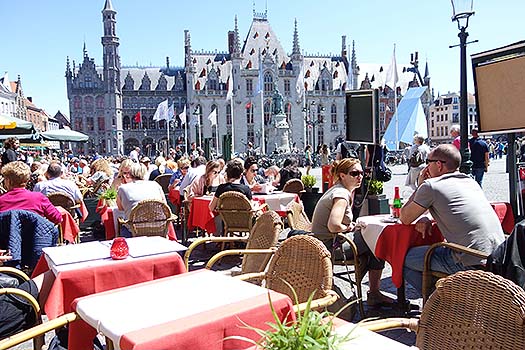 |
 |
 |
| Bruges main square | The bell tower | More bell tower |
 |
 |
 |
| Our captain | On the canal | More canal |
 |
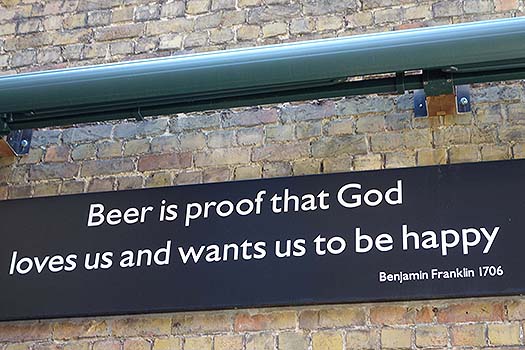 |
 |
| The beermobile | Words of beery wisdom | Beer museum |
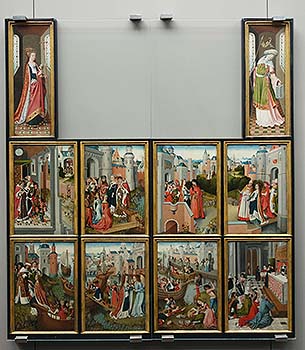 |
 |
 |
| An early comic strip | Tree art | More art |
On June 7, we set out for Normandy. Our targets were the Bayeux tapestry and the Normandy beaches. It was a fairly long drive and we arrived in Bayeux around 4 o'clock. We checked into our hotel and straightaway rushed out to bag the tapestry before it closed. It turned out to be a good move; the endless lines of tourists had left and we almost had the tapestry to ourselves. It was an amazing sight, looking at a tapestry 70 meters long dating back to the Norman conquest in 1066. It was, in fact, a linear comic book, illustrating how the old English king had decided to leave the throne to bastard cousin Bill, who lived in France. That seems a little odd, but then you have to remember that King Edward himself spent much of his life in France after being exiled from England. He could have left the throne to step-son Harold, but decided against it. He then sent Harold to France to tell Bill the good news. Bill was happy but a little concerned that Harold might decide to take the throne for himself, so he made Harold swear a great oath on an authentic fragment of St Peter's toenail that he would be true to King Edward's wishes. Hey, no problem! said Harold and went back to England, but, sure enough, when King Edward died, Harold went back on his oath and proclaimed himself king. When Bill learned of this turn of events, he decided to fulfill King Edward's wishes and teach Harold a lesson in the process. He ordered trees to be cut, planks to be sawn, boats to be built, to be filled with horses, knights, food and a large barrel of fine wine. Then they all embarked and sailed across the channel. Harold wasn't in London when Bill landed but off in the North, driving off Viking raiders. His exact words when told that Bill was waiting for him in Hastings are not known, but they might have included some expression of regret about not showing more respect for St Peter's toenail.
After a lively battle, Harold got an arrow in his eye and died while Bill fought his way to London where the archbishop was happy to arrange for yet another coronation. And we've been calling sheep mutton ever since.
It is incredible that the tapestry can be in such good shape after almost one thousand years. Not only does it tell the story of this event that every schoolchild has to learn about, but it includes marginal notes showing Halley's comet (thought to be a bad omen, but for whom?) The only difficulty for the casual tourist is that the lettering is all in Latin, so I have created an example of how it might be rendered into English here.
As well as the tapestry, Bayeux has a very fine cathedral, which was just across from our hotel and which we visited first thing the next day. I have no idea why a relatively small town like Bayeux should merit such a wonderful building. They have hitched their wagon to the tapestry, which they remove from the museum each year for a short time in order to display it in the church. I guess they are making clear that it was God's will that the Normans should invade England and civilize the inhabitants.
After the cathedral, we went to pay our respects to the other Norman invasion of June 6 1944, when American, British and other allied troops landed on the Normandy beaches in preparation for driving the German army back to Germany. We first went to Arromanches, which was one of the first towns to be liberated by the Allies and which has a museum with exhibits and a couple of ancient field pieces. After touring the museum, we drove south to see Omaha and Utah beaches, which are where the Americans landed. There was a large visitor center which managed to convey just what a huge operation the landing was. Outside, the weather was mostly sunny but very windy. There were memorials everywhere, many with a trail of cut flowers that had been blown away by the wind.
The beach was beautiful and serene, contrasting sharply with the photos of landing craft, obstacles and streams of soldiers we had just been seeing in the visitor center. Louise also visited the cemetery, which she found very moving - especially those "known only to God".
We then drove North again to Berck, the town where the Vincents own a house next to the beach and where they very kindly suggested we stay. The house had about six bedrooms and could sleep a regiment. It is about a five minute drive to the center of town, where there are plenty of shops, restaurants and trinket salesmen. We mostly relaxed and strolled on the beach. For breakfast, we went to the Hippo Cafe, where I confidently announced ourselves and requested menus in fluent French. The waiter turned out to be from Yorkshire but had lived in Berck for the past three years. We then had a good chat (in English) and he furnished us with a map and suggestions for places to visit.
When we first went on the beach, we were astounded by how huge it is. Like Mont St. Michel, the beach has a very shallow slope; when the tide is out, the sea is so far out that you can hardly see it, but when the tide comes in, the water can come roaring up the beach at an alarming rate. It was quite sunny but windy and cool and we both had our woolies on. Our first stroll took us south, past a class in sand yachting (which looked like fun but a bit scary in all the wind), to the town esplanade. Beyond the esplanade was an inlet where there is a seal colony, which we inspected and which inspected us. The next day, we went north, where there were all kinds of cool German fortifications in an advanced state of decay and mostly covered with grafitti.
On Friday, our last evening in Berck, we went into town and had a fine meal. I had mussels, which were not only delicious but too numerous even for me to finish.
The next day, we left early for Lille, arriving at the town hall about 11:30. In France, marriage is defined by a civil ceremony - a religious service doesn't count. Before the assembled multitude, the mayor read a list of the statutes that must be obeyed and Anne-Sophie and Thibaut agreed. Case closed.
Then off to church (l'Eglise Saint-Andre) for brief ceremony there, and then to the Chateau de Bourgogne in Estaimbourg, just over the border in Belgium, for wine, food and celebration. We were seated with the Vincents and other of their English-speaking friends and felt very special. There were fun and games till the wee hours, though we slipped out at 10. We had a reservation at the Villa White Cloud nearby, where we spent the night.
Off to Ghent the next day, which, like Bruges, has an amazing number of ancient buildings. Unlike Bruges, it was a thriving cloth manufacturing center for many years and all that industrial activity coated the ancient buildings with a thick layer of grime. It wasn't until the last century that the city decided to go for the tourist trade and scraped off all the grime. Now it competes with Bruges for the tourist dollar. It seems a little less crowded than Bruges, which appealed to us, and it has a kick-ass castle in the middle of everything.
After Ghent, we drove straight to the Brussels airport, dumped the rental car and spent the night at the Sheraton, right across from the terminal. Above right is a remarkable piece of 3D art in the lobby, depicting, I believe, the reaction of the Selenites in 1969 on seeing the Apollo landing.
Our flight was at noon and we had another smooth trip home. We were psyched to see the cats after such a long absence - the Ruskies seemed glad to see us but Tillie didn't recognize us at first and hissed at us if we came too close. But after a little while she decided we were OK and peace descended upon our household.
Copyright © 2002 by Peter Lloyd-Davies. All rights reserved. Privacy Statement.